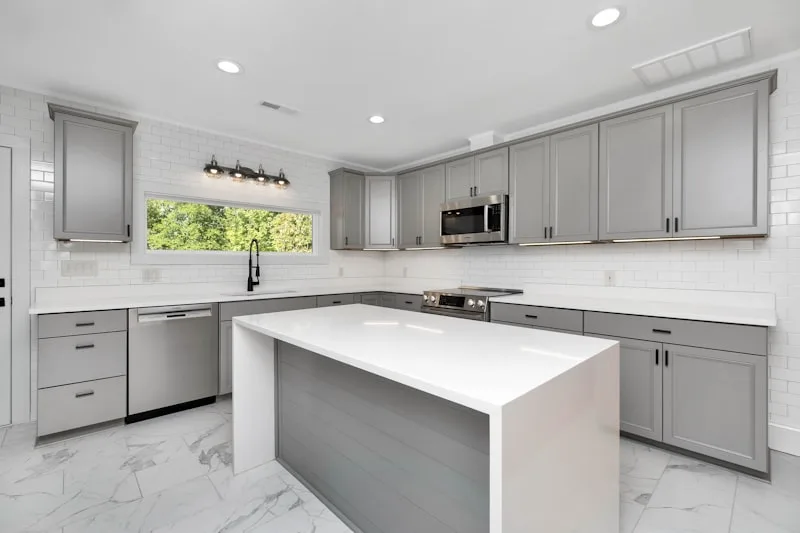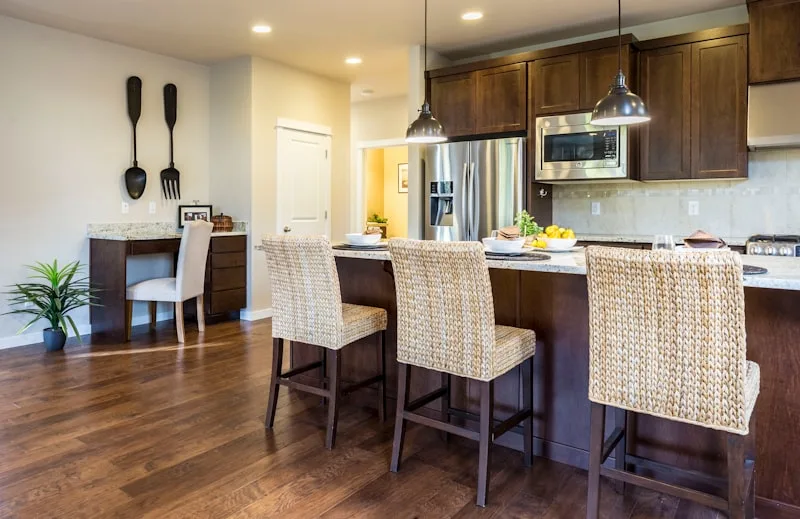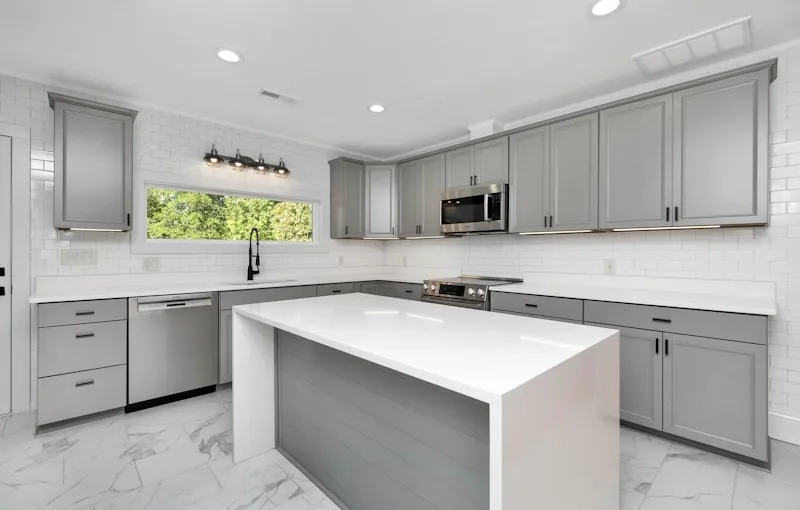First off, the type of painter’s tape you use can make a world of difference. High-quality painter’s tape is designed to peel off cleanly without leaving a sticky residue or damaging the surface underneath. Think of it like a gentle hug for your cabinets—supportive but not clingy! If you opt for the cheaper stuff, however, you might end up with a sticky mess that could pull away some of that beautiful finish you worked so hard to achieve.
Now, let’s talk about timing. If you let the tape sit too long, it can bond with the finish, making it more likely to cause damage when you finally decide to remove it. It’s like leaving a piece of gum under your shoe for too long—it’s going to be a sticky situation! The best practice is to remove the tape while the paint is still slightly wet or right after it’s dried, but not too long after.
Also, consider the finish of your cabinets. Glossy finishes tend to be more resilient, while matte finishes can be a bit more delicate. If you’re unsure, test a small, inconspicuous area first. It’s like dipping your toes in the water before diving in—better safe than sorry!
So, will painter’s tape damage your kitchen cabinet finish? With the right tape, timing, and a little caution, you can keep your cabinets looking pristine and avoid any unnecessary drama. Happy painting!
Peeling Back the Truth: Does Painter’s Tape Ruin Your Kitchen Cabinet Finish?
Imagine you’ve just spent hours meticulously painting your cabinets, and the last thing you want is for that beautiful finish to be marred by tape residue or, worse, peeling paint. It’s a nightmare scenario, right? The truth is, the impact of painter’s tape on your cabinet finish largely depends on a few key factors. First off, the quality of the tape matters. Cheap tape might stick too well, leaving behind a sticky mess or even pulling off some of that fresh paint when you remove it. Think of it like using a flimsy umbrella in a storm—it’s just not going to hold up.
Next, consider the type of finish on your cabinets. If you’ve got a glossy or lacquered surface, painter’s tape is generally safe. But if your cabinets are painted with a more delicate finish, like chalk paint, you might want to tread carefully. It’s like walking on eggshells—one wrong move, and you could crack that beautiful surface.
Timing is also crucial. If you let the tape sit too long, it can bond with the finish, making it harder to remove without damage. It’s like leaving a sticker on your favorite book; eventually, it’s going to leave a mark. So, when you’re ready to remove that tape, do it while the paint is still slightly tacky for the best results.

In the end, painter’s tape can be your best friend or your worst enemy, depending on how you use it. So, choose wisely, and your kitchen cabinets will thank you!
Painter’s Tape Dilemma: Protecting Your Cabinets While Getting the Job Done
So, how do you tackle this challenge? First off, let’s talk about the importance of prep work. Think of painter’s tape as your trusty sidekick. It’s there to save the day, but only if you use it right. Start by cleaning the surfaces you plan to tape. Dust and grease are like that annoying friend who shows up uninvited; they’ll ruin your plans if you don’t kick them out first. Once everything’s clean, apply the tape carefully, pressing down firmly to seal the edges. This is where the magic happens—good tape can make the difference between a crisp line and a paint disaster.
Now, here’s a pro tip: don’t rush the process. It’s tempting to dive right in, but patience is key. If you’re painting cabinets, consider using a high-quality tape designed for delicate surfaces. It’s like choosing the right tool for the job; the right tape will peel away cleanly without taking any paint with it. And remember, when you’re ready to remove the tape, do it slowly and at a 45-degree angle. It’s like unwrapping a gift—take your time to enjoy the reveal!
So, the next time you face the painter’s tape dilemma, remember: with a little prep and the right technique, you can protect your cabinets and achieve that flawless finish you’ve been dreaming of. Happy painting!
The Great Debate: Can Painter’s Tape Leave a Mark on Your Kitchen Cabinets?
Let’s break it down. Painter’s tape is designed to create clean lines, but not all tapes are created equal. Some are gentler than others, especially those labeled as “low-tack.” Think of them as the soft-spoken friends who know how to handle delicate situations. If you’re using a high-tack tape on a glossy finish, you might as well be inviting trouble to your kitchen party. The adhesive can bond too tightly, leading to peeling paint or even damaging the surface underneath.
Now, imagine you’re trying to impress your friends with a fresh, modern look, and instead, you end up with a patchy disaster. Not cool, right? To avoid this, always test a small, inconspicuous area first. It’s like dipping your toes in the water before diving in—better safe than sorry!
And here’s a pro tip: when you’re ready to remove the tape, do it slowly and at a 45-degree angle. This technique is like unwrapping a gift; you want to savor the moment and ensure everything stays intact. So, while painter’s tape can be your best friend in a DIY project, it’s essential to choose wisely and handle it with care to keep your kitchen cabinets looking sharp and pristine.
Tape Tactics: How to Safely Use Painter’s Tape Without Damaging Your Cabinets
First off, prep is key. Think of painter’s tape as a relationship; it needs a solid foundation. Start by cleaning the surface of your cabinets. Dust and grease are like bad vibes—they’ll ruin your connection with the tape. Once everything’s squeaky clean, it’s time to apply the tape. Stick it down firmly, but don’t go overboard. You want it to hug the surface, not suffocate it.
Now, here’s a pro tip: burnish the edges of the tape with a putty knife or your fingernail. This little move creates a seal that keeps paint from sneaking underneath. It’s like putting on a raincoat before heading out; you want to stay dry, right?

When it’s time to paint, use a brush or roller that’s not too loaded with paint. Think of it as a gentle caress rather than a heavy-handed slap. And when you’re done, resist the urge to rip the tape off immediately. Let the paint dry for a bit, then peel it back slowly at a 45-degree angle. This way, you’re less likely to pull off any of that gorgeous paint you just applied.
So, there you have it! With these tape tactics, you can transform your cabinets without the fear of damage. It’s all about finesse, patience, and a little bit of love. Happy painting!
Kitchen Cabinet Care: What You Need to Know About Painter’s Tape and Finishes
Painter’s tape is your best friend in this process. It’s like a safety net for your cabinets, ensuring that paint doesn’t wander where it shouldn’t. Have you ever tried to paint a straight line without it? It’s like trying to cut a cake with a dull knife—messy and frustrating! By applying painter’s tape along the edges of your cabinets, you create a clean barrier that keeps your paint job looking sharp and professional. Plus, it saves you from the headache of touch-ups later on.
Now, let’s talk finishes. The finish you choose for your cabinets is crucial. Think of it as the protective armor that shields your cabinets from daily wear and tear. Whether you opt for a glossy sheen or a matte look, each finish has its own personality. A glossy finish can make your kitchen feel bright and airy, while a matte finish offers a cozy, rustic vibe. But remember, not all finishes are created equal. Some are more resistant to stains and scratches, making them ideal for high-traffic areas like kitchens.
Frequently Asked Questions
Will painter’s tape leave residue on my kitchen cabinets?
Painter’s tape is designed to minimize residue, but it can sometimes leave a sticky residue on kitchen cabinets, especially if left on for an extended period or if the surface is not properly prepared. To avoid this, remove the tape while the paint is still wet or use a low-tack tape specifically made for delicate surfaces.
What type of painter’s tape is safe for cabinet finishes?
For cabinet finishes, use low-tack painter’s tape designed for delicate surfaces. This type minimizes the risk of damaging the finish while providing clean lines during painting. Look for tapes labeled as safe for use on wood, lacquer, or varnish to ensure optimal results.
How to safely remove painter’s tape from kitchen cabinets?
To safely remove painter’s tape from kitchen cabinets, start by ensuring the paint is fully dry. Gently pull the tape away at a 45-degree angle to minimize the risk of peeling paint. If the tape is stubborn, use a utility knife to carefully score along the edge before pulling. For best results, remove the tape slowly and steadily to avoid any damage to the cabinet surface.
How long can I leave painter’s tape on kitchen cabinets?
Painter’s tape can typically be left on kitchen cabinets for up to 14 days without risking damage to the surface. However, for best results, it’s advisable to remove the tape within a few hours after painting to ensure clean lines and prevent adhesive residue.
Can painter’s tape damage the finish of my cabinets?
Using painter’s tape can potentially damage the finish of cabinets, especially if the tape is left on for an extended period or if the finish is already weak. To minimize risk, ensure the surface is clean, use a low-tack tape, and remove it promptly after painting.
